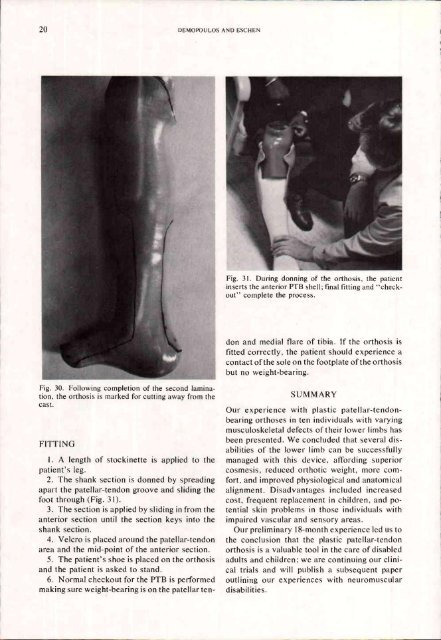Orthotics and Prosthetics
Orthotics and Prosthetics
Orthotics and Prosthetics
You also want an ePaper? Increase the reach of your titles
YUMPU automatically turns print PDFs into web optimized ePapers that Google loves.
Fig. 31. During donning of the orthosis, the patient<br />
inserts the anterior PTB shell; final fitting <strong>and</strong> "checkout"<br />
complete the process.<br />
1. A length of stockinette is applied to the<br />
patient's leg.<br />
2. The shank section is donned by spreading<br />
apart the patellar-tendon groove <strong>and</strong> sliding the<br />
foot through (Fig. 31).<br />
3. The section is applied by sliding in from the<br />
anterior section until the section keys into the<br />
shank section.<br />
4. Velcro is placed around the patellar-tendon<br />
area <strong>and</strong> the mid-point of the anterior section.<br />
5. The patient's shoe is placed on the orthosis<br />
<strong>and</strong> the patient is asked to st<strong>and</strong>.<br />
6. Normal checkout for the PTB is performed<br />
making sure weight-bearing is on the patellar tendon<br />
<strong>and</strong> medial flare of tibia. If the orthosis is<br />
fitted correctly, the patient should experience a<br />
contact of the sole on the footplate of the orthosis<br />
but no weight-bearing.<br />
Fig. 30. Following completion of the second lamination,<br />
the orthosis is marked for cutting away from the<br />
cast.<br />
FITTING<br />
SUMMARY<br />
Our experience with plastic patellar-tendonbearing<br />
orthoses in ten individuals with varying<br />
musculoskeletal defects of their lower limbs has<br />
been presented. We concluded that several disabilities<br />
of the lower limb can be successfully<br />
managed with this device, affording superior<br />
cosmesis, reduced orthotic weight, more comfort,<br />
<strong>and</strong> improved physiological <strong>and</strong> anatomical<br />
alignment. Disadvantages included increased<br />
cost, frequent replacement in children, <strong>and</strong> potential<br />
skin problems in those individuals with<br />
impaired vascular <strong>and</strong> sensory areas.<br />
Our preliminary 18-month experience led us to<br />
the conclusion that the plastic patellar-tendon<br />
orthosis is a valuable tool in the care of disabled<br />
adults <strong>and</strong> children; we are continuing our clinical<br />
trials <strong>and</strong> will publish a subsequent paper<br />
outlining our experiences with neuromuscular<br />
disabilities.
















